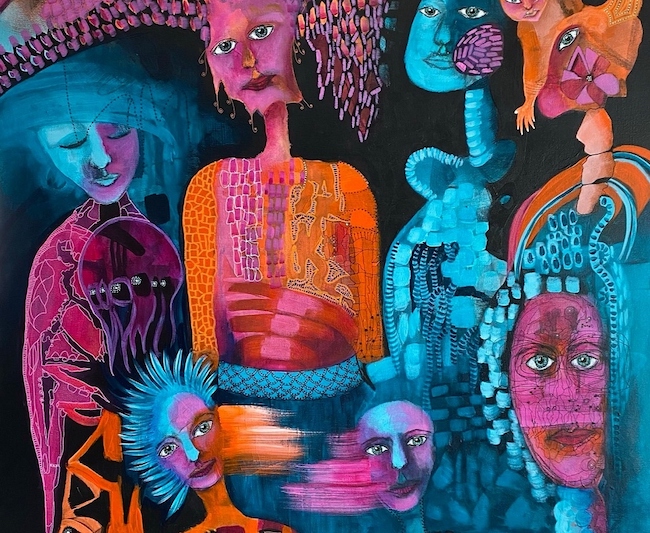Le emozioni più profonde e intime spesso vengono nascoste dall’individuo per evitare di sentirsi esposto, vulnerabile, pur conoscendo l’importanza di non accantonarle, di non riporle in un angolo nel quale è possibile fingere e credere di non vederle; la tendenza di alcuni artisti è quella di andare a scavare nel profondo, proprio o di chi passa loro a fianco, per portare alla luce sensazioni e percezioni che contraddistinguono il vivere contemporaneo. La protagonista di oggi manifesta la spiccata caratteristica di dar voce al sentire con un singolare e personale stile pittorico.
Nel corso del Diciannovesimo secolo cominciò ad assumere rilevanza mettere in primo piano l’interiorità, la spiritualità e l’emotività che esisteva nella realtà osservata senza però che venisse colta in maniera immediata; gli artisti che seguirono questo percorso espressivo diedero vita al Simbolismo in cui la figurazione non poteva prescindere dal sentire profondo, dalla sensazione che pervade l’individuo in ogni frammento della sua vita. Gli artisti simbolisti, di cui Odilon Redon e Gustave Moreau furono i principali esponenti, aprirono la strada a un mondo pittorico più legato alle profondità dell’animo umano che più avanti, nei primi decenni del Novecento, si concretizzò con l’Espressionismo prima e con il Surrealismo poi. La necessità di dare spazio e priorità a tutto ciò che ruotava all’interno del mondo intimo e profondo indusse gli espressionisti a rinunciare alla forma estetica, alle regole pittoriche più tradizionali come la profondità, la prospettiva, l’aderenza alla realtà e al chiaroscuro, che invece erano ancora presenti nel Simbolismo; l’Espressionismo sovvertì le regole, trasformò i colori assecondandoli alle sensazioni ricevute da ciò che veniva osservato rendendoli così irreali, improbabili quanto però intensi e travolgenti per l’impatto emotivo che da essi si sprigionava, e infine rinunciò completamente alla bellezza e all’armonia per descrivere il mondo attraverso il filtro della propria sensibilità, o rabbia o inquietudine consegnando alla storia capolavori indimenticabili. Laddove artisti come Edvard Munch, Egon Schiele e James Ensor, solo per citare alcuni esponenti, manifestarono chiaramente e inequivocabilmente ciò che avvertivano e osservavano dal mondo intorno a sé, i Surrealisti si proposero invece di indagare l’inconscio, i sogni e gli incubi a cui durante il giorno era difficile attribuire un significato, entrando dunque in un campo artistico più interpretativo, più nascosto e stimolante per indurre a riflettere sul concetto e il significato profondo oltre le immagini. Nel caso dei surrealisti lo stile pittorico era più classico, con un’attinenza maggiore alla forma così come colta dallo sguardo, pur illustrando luoghi e oggetti sospesi e decontestualizzati che infondevano una sensazione di irreale. L’artista tedesca Inge Zuck ha uno stile in cui entrambi i movimenti del passato, Espressionismo e Surrealismo, sembrano coesistere e sintetizzarsi per manifestare la sua esigenza di portare alla luce le sensazioni dell’individuo contemporaneo, quel vortice di pensieri e di modi di affrontare la realtà che contraddistinguono la vita attuale e che spesso vengono tenuti nascosti, oppure osservati con stupore e sorpresa da chi li sta vivendo, o ancora che restano nell’inconsapevolezza di chi ne è attore e protagonista.
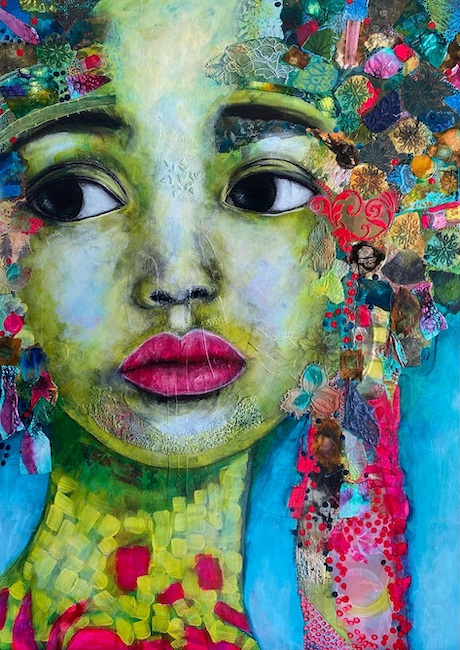
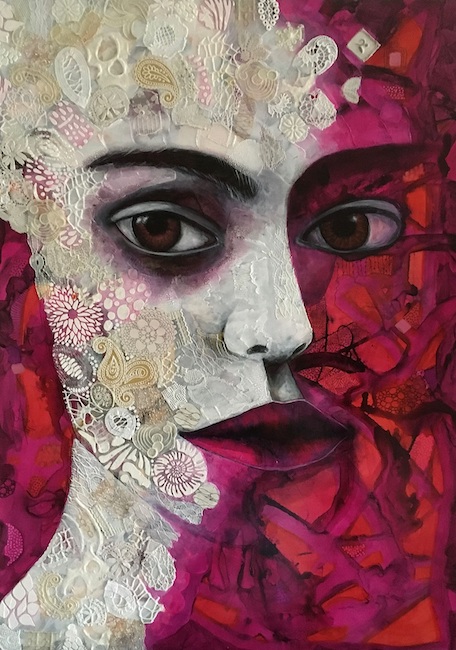
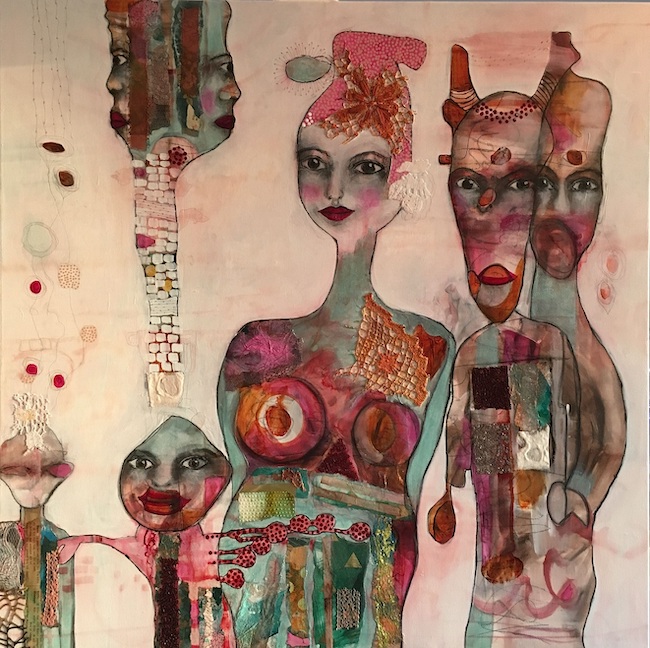
Il tratto pittorico e le tonalità vivaci, intense e in accordo con le emozioni che avvolgono ciò da cui lo sguardo dell’artista è catturato, sono pienamente espressioniste, tanto quanto la semplicità della raffigurazione, la descrizione poco definita della fisicità dei personaggi che lascia completo spazio a tutto quanto si intraveda dell’interiorità; la decontestualizzazione di alcuni dettagli, i simboli che si celano oltre l’apparenza, così come l’inquietudine che a volte fuoriesce dagli sguardi dei suoi soggetti, appartengono invece a quel mondo surrealista che tutto punta a svelare e che destabilizza l’ordine razionale della realtà per far emergere il mistero, l’enigma che appartiene al mondo assurdo e folle in cui la mente umana si muove.
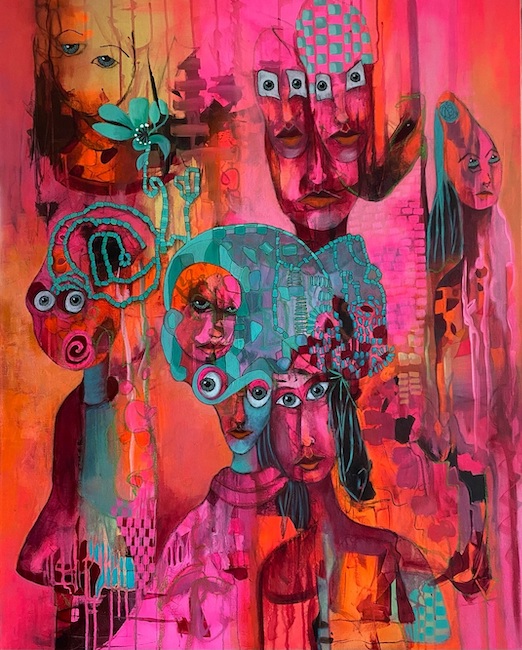
Questo tipo di angoscia e di disorientamento emerge in modo chiaro nella tela Zusammenhalten (Essere uniti) nella quale la vicinanza tra le figure protagoniste sembra generare timore, sospetto, irrequietezza per la mancanza di fiducia che avvolge l’esistenza contemporanea in cui l’altro è spesso considerato come contrapposto, come una minaccia piuttosto che parte di una comunità solidale e disponibile all’aiuto e all’accoglienza. Inge Zuck in quest’opera evidenzia e sottolinea i differenti approcci del singolo, qualcuno più aperto e fiducioso, altri invece distaccati e immersi nella propria solitudine e altri ancora smarriti all’interno delle proprie paure; le tonalità scelte si avvicendano passando da colori freddi a colori più caldi, sulla base delle emozioni che l’artista fa emergere, e rappresentano le differenze di percezione e di sensazione che sono le uniche a differenziare gli individui, più che il colore della pelle o la credenza religiosa.
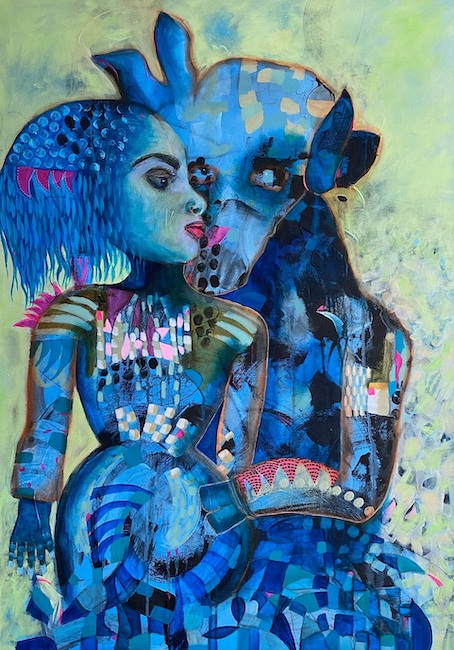
Anche in Innere-Schonheit (Bellezza interiore) la Zuck sembra esortare l’osservatore ad andare oltre, a non fermarsi a quella forma esteriore che spesso devia l’attenzione da tutto ciò che appartiene alle caratteristiche di un individuo come il carattere, il mondo intimo e morbido che non necessariamente deve trasparire all’esterno; la donna mostra amore per il mostro dietro di se che sembra circuirla in maniera dolce e amabile, esattamente come nella favola La Bella e la Bestia in cui la capacità di dare rilevanza a ciò che le persone hanno all’interno del loro mondo emotivo diviene morale e invito ad apprendere quanto l’estetica possa essere trascurabile davanti ai sentimenti profondi. Malgrado l’utilizzo di colori freddi l’atmosfera che la Zuck riesce a far trapelare è romantica, avvolgente e di trasporto reciproco della bizzarra coppia.
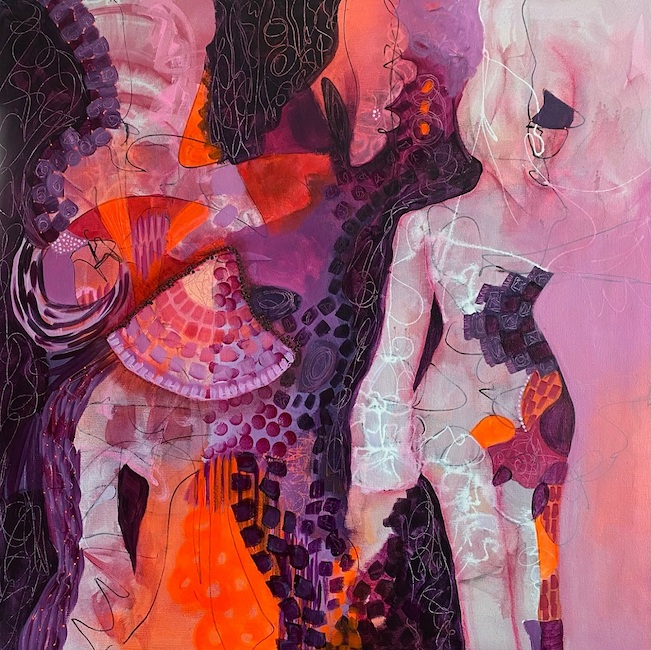
Nell’opera Abgenabelt (Tagliato fuori) l’artista affronta il tema dell’emarginazione, di quel sentirsi a volte invisibili nella moltitudine perché quasi incapaci di riuscire a comunicare, di affermare la propria personalità e individualità scegliendo così, quasi volutamente, di restare ai margini e preferendo in alcuni casi l’impercettibilità piuttosto che il coraggio di far emergere la vera natura; nell’opera Inge Zuck lascia trapelare un mondo colorato, le tonalità sono sulla scala dei rosa e dei viola, vivaci, affascinanti e coinvolgenti mentre la figura a lato, l’escluso, diviene evanescente, immateriale proprio in virtù di un approccio defilato condannando di fatto se stesso a essere mero spettatore di un mondo vivo a cui però è necessario mostrarsi e affermare la propria identità per diventarne parte.
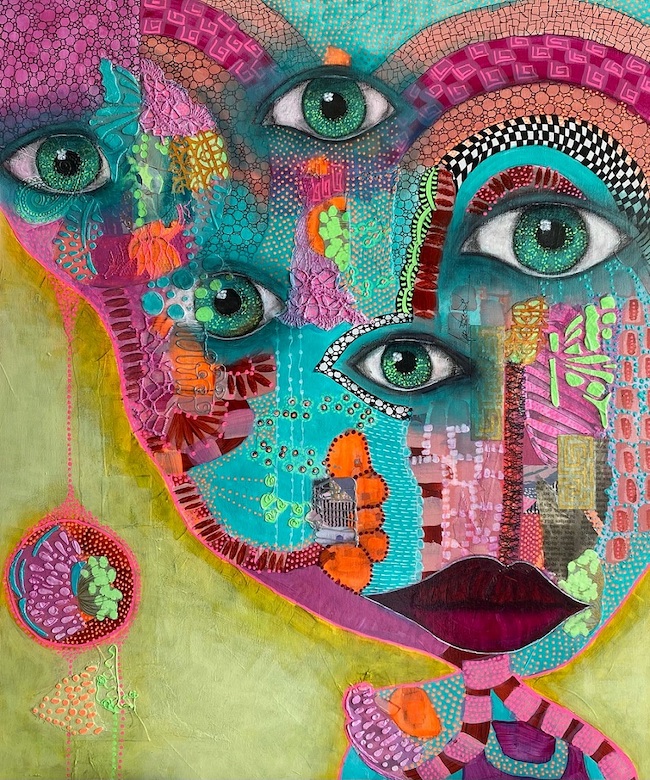
I contasti cromatici che si alternano alle più morbide sfumature ma anche i collage sono le caratteristiche distintive delle tele di Inge Zuck, così come la focalizzazione sugli occhi, a volte narranti un’emozione personale, altre invece ripetuti per enfatizzare il messaggio del titolo dell’opera, come in Neugier (Curiosità) che spesso può sfociare in un’eccessiva attenzione alle vite e all’intimità degli altri, ecco perché gli sguardi sono moltiplicati e dalla duplice valenza, quella positiva dello stimolo alla conoscenza e quella negativa dell’ingerenza e la tendenza al pettegolezzo. Nel corso della sua carriera artistica Inge Zuck, formatasi da autodidatta ma con una forte impronta espressiva, ha esposto a Vienna, Salisburgo, Innsbruck, Praga, Venezia, San Marino, Montecosaro, Verona, Lerici, Cervia, Ravenna, Bertinoro, Ferrara, all’Artbox Project World 1.0, Art Basel Miami, Barcellona, Swissartexpo di Zurigo.
INGE ZUCK-CONTATTI
Email: inge@inge-zuck.com
Sito web: www.inge-zuck.com
Facebook: https://www.facebook.com/Inge5Zuck6Art
Instagram: https://www.instagram.com/inge.zuck.art/
Journey through the human interiority between Expressionism and Surrealism with the artworks of Inge Zuck
The deepest and most intimate emotions are often hidden by the individual in order to avoid feeling exposed and vulnerable, even though they know the importance of not setting them aside, of not storing them in a corner where it is possible to pretend and believe not to see them. The tendency of some artists is to dig deep within themselves or those who pass by them, to bring to light the sensations and perceptions that distinguish contemporary life. Today’s protagonist manifests the distinct characteristic of giving voice to feeling with a singular and personal pictorial style.
During the nineteenth century, it began to take on importance to bring to the forefront the interiority, spirituality and emotionality that existed in the reality observed without, however, being grasped immediately; the artists who followed this expressive path gave life to Symbolism in which figuration could not ignore the deep feeling, the sensation that pervades the individual in every fragment of his life. The Symbolist artists, of whom Odilon Redon and Gustave Moreau were the main exponents, paved the way for a pictorial world more closely linked to the depths of the human soul, which later, in the first decades of the 20th century, took shape first with Expressionism and then with Surrealism. The need to give space and priority to everything that revolved within the intimate and profound world led the Expressionists to renounce aesthetic form, the more traditional pictorial rules such as depth, perspective, adherence to reality and chiaroscuro, which were still present in Symbolism; Expressionism subverted the rules, transforming colours to suit the sensations received by what was being observed, making them unreal, improbable yet intense and overwhelming in their emotional impact, and finally renouncing beauty and harmony altogether in order to describe the world through the filter of its own sensitivity, or anger or anxiety, and consigning unforgettable masterpieces to history. Whereas artists such as Edvard Munch, Egon Schiele and James Ensor, to name but a few, clearly and unequivocally manifested what they sensed and observed from the world around them, the Surrealists instead set out to investigate the unconscious, dreams and nightmares to which it was difficult during the day to attribute meaning, thus entering a more interpretive, more hidden and stimulating artistic field to prompt reflection on the concept and deeper meaning beyond the images.
In the case of the Surrealists, the style of painting was more classical, with a greater adherence to form as captured by the eye, while illustrating suspended and decontextualised places and objects that conveyed a feeling of the unreal. The German artist Inge Zuck has a style in which both movements of the past, Expressionism and Surrealism, seem to coexist and synthesise to express her need to bring to light the sensations of the contemporary individual, that whirlwind of thoughts and ways of dealing with reality that characterise current life and that are often kept hidden, or observed with astonishment and surprise by those who are living them, or that remain unconscious by those who are actors and protagonists. The pictorial line and the bright, intense colours, in keeping with the emotions that envelop the artist’s gaze, are fully expressionist, as much as the simplicity of the depiction, the ill-defined description of the physicality of the characters, which leaves complete space for everything that can be glimpsed from within; the decontextualisation of certain details, the symbols that are concealed beyond appearance, as well as the disquiet that sometimes emerges from the gazes of her subjects, belong instead to that surrealist world that aims to unveil everything and that destabilises the rational order of reality to bring out the mystery, the enigma that belongs to the absurd and crazy world in which the human mind moves. This type of anguish and disorientation emerges clearly in the painting Zusammenhalten (To be united) in which the closeness between the protagonist figures seems to generate fear, suspicion, restlessness due to the lack of trust that surrounds contemporary existence in which the other is often considered as an opponent, as a threat rather than part of a community of solidarity and willingness to help and welcome.
Inge Zuck’s work highlights and underlines the different approaches of individuals, some more open and trusting, others more detached and immersed in their own loneliness, and others still lost in their own fears; the shades chosen alternate from cool to warmer colours, based on the emotions the artist brings out, and represent the differences in perception and sensation that are the only ones that differentiate individuals, rather than skin colour or religious belief. In Innere-Schonheit (Inner Beauty) Zuck also seems to urge the viewer to go further, not to stop at the outward form that often diverts attention from everything that belongs to the characteristics of an individual such as character, the intimate and soft world that does not necessarily have to transpire on the outside; the woman shows love for the monster behind her who seems to be circling her in a sweet and lovable way, just like in the fairy tale Beauty and the Beast in which the ability to give importance to what people have inside their emotional world becomes moral and an invitation to learn how aesthetics can be negligible in front of deep feelings. Despite the use of cold colours, the atmosphere that Zuck manages to convey is romantic, embracing and of mutual transport of the bizarre couple. In Abgenabelt (Cut off) the artist tackles the theme of marginalisation, of feeling at times invisible in the crowd because of incapacity of communicating, of affirming a personality and individuality, choosing, almost deliberately, to remain on the margins and preferring in some cases to be imperceptible rather than having the courage to reveal the true nature; Inge Zuck’s artwork reveals a colourful world, the shades are on the scale of pinks and purples, lively, fascinating and involving, while the figure on the side, the excluded, becomes evanescent, immaterial precisely because of his defiladed approach, condemning himself to be a mere spectator of a living world to which, however, he must show himself and affirm his identity in order to become part of it.
The chromatic contrasts that alternate with the softest nuances, but also the collages, are the distinctive characteristics of Inge Zuck’s canvases, as is the focus on the eyes, at times narrating a personal emotion, at others repeated to emphasise the message of the work’s title, as in Neugier (Curiosity), which can often result in excessive attention to the lives and intimacy of others, which is why the gazes are multiplied and have a double valence, the positive one of stimulating knowledge and the negative one of interfering and gossiping. During her artistic career, Inge Zuck, self-taught but with a strong expressive imprint, has exhibited in Vienna, Salzburg, Innsbruck, Prague, Venice, San Marino, Montecosaro, Verona, Lerici, Cervia, Ravenna, Bertinoro, Ferrara, at Artbox Project World 1.0, Art Basel Miami, Barcelona, Swissartexpo in Zurich.
INGE ZUCK-CONTACTS
Email: inge@inge-zuck.com
Website: www.inge-zuck.com
Facebook: https://www.facebook.com/Inge5Zuck6Art
Instagram: https://www.instagram.com/inge.zuck.art/


